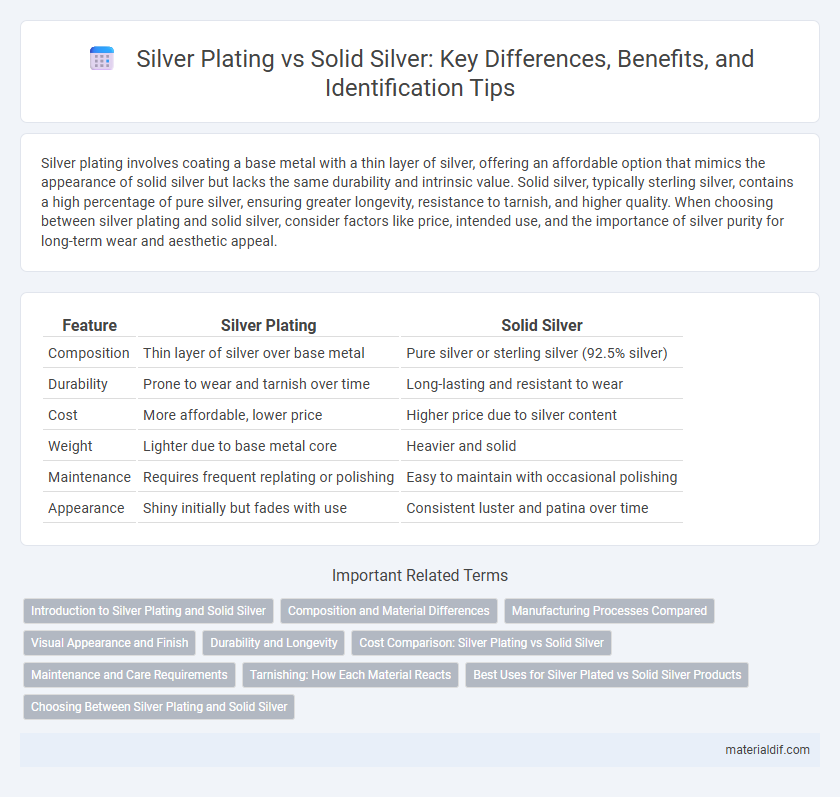Silver plating involves coating a base metal with a thin layer of silver, offering an affordable option that mimics the appearance of solid silver but lacks the same durability and intrinsic value. Solid silver, typically sterling silver, contains a high percentage of pure silver, ensuring greater longevity, resistance to tarnish, and higher quality. When choosing between silver plating and solid silver, consider factors like price, intended use, and the importance of silver purity for long-term wear and aesthetic appeal.
Table of Comparison
| Feature | Silver Plating | Solid Silver |
|---|---|---|
| Composition | Thin layer of silver over base metal | Pure silver or sterling silver (92.5% silver) |
| Durability | Prone to wear and tarnish over time | Long-lasting and resistant to wear |
| Cost | More affordable, lower price | Higher price due to silver content |
| Weight | Lighter due to base metal core | Heavier and solid |
| Maintenance | Requires frequent replating or polishing | Easy to maintain with occasional polishing |
| Appearance | Shiny initially but fades with use | Consistent luster and patina over time |
Introduction to Silver Plating and Solid Silver
Silver plating involves coating a base metal, such as copper or nickel, with a thin layer of pure silver through electroplating techniques, offering the aesthetic appeal of silver at a lower cost. Solid silver, commonly represented by sterling silver which contains 92.5% pure silver alloyed with other metals like copper, provides superior durability, value, and tarnish resistance compared to plated alternatives. Understanding the difference in composition and longevity is crucial for consumers seeking quality, affordability, and maintenance requirements in silver products.
Composition and Material Differences
Silver plating involves a thin layer of pure silver applied over a base metal like copper, brass, or nickel, offering an affordable alternative to solid silver with a similar appearance. Solid silver, commonly in the form of sterling silver, consists of 92.5% pure silver alloyed with 7.5% other metals, usually copper, for enhanced durability and strength. The key material difference lies in silver plating's superficial silver layer, which can wear off over time, whereas solid silver maintains its composition throughout, ensuring lasting value and performance.
Manufacturing Processes Compared
Silver plating involves electro-depositing a thin layer of silver onto a base metal, using processes like electrolysis to achieve a uniform coating. Solid silver manufacturing requires melting and alloying pure silver, often 92.5% purity for sterling silver, followed by casting or rolling into the desired shape. The plating process is faster and more cost-effective, whereas solid silver demands extensive refining and shaping for durability and intrinsic value.
Visual Appearance and Finish
Silver plating features a thin layer of silver over a base metal, giving it a shiny, reflective surface that can closely mimic the look of solid silver. Solid silver, typically 92.5% pure sterling silver, offers a naturally lustrous finish with a depth and richness that silver plating cannot fully replicate. Over time, solid silver develops a unique patina that enhances its visual appeal, whereas silver-plated items may show wear and base metals beneath, diminishing their finish.
Durability and Longevity
Silver plating offers a thin layer of silver over a base metal, making it more prone to wear, tarnish, and corrosion over time. Solid silver, typically sterling silver with 92.5% pure silver, provides greater durability and maintains its appearance with proper care for decades or even centuries. Choosing solid silver ensures a lasting investment in items that withstand daily use without significant degradation.
Cost Comparison: Silver Plating vs Solid Silver
Silver plating offers a significantly lower cost compared to solid silver, as it involves a thin layer of silver applied over a base metal. Solid silver, typically 92.5% pure sterling silver, commands a higher price due to its substantial silver content and durability. While silver plating provides an affordable alternative for decorative items, solid silver is preferred for investment and long-term wear due to its intrinsic value and resistance to wear.
Maintenance and Care Requirements
Silver plating requires more frequent cleaning to prevent tarnish due to its thin layer of silver coating over a base metal. Solid silver, particularly sterling silver, is more durable and can be polished regularly without risk of exposing underlying metals, making maintenance simpler and longer-lasting. Proper storage in anti-tarnish cloths and avoiding exposure to harsh chemicals extends the lifespan of both silver-plated and solid silver items.
Tarnishing: How Each Material Reacts
Silver plating consists of a thin layer of silver bonded to a base metal, which makes it more prone to tarnishing as the underlying metal can react with air and moisture once the silver layer wears thin. Solid silver, typically 92.5% pure in sterling silver, tarnishes more slowly because the entire piece is made of silver, but it still develops a patina due to sulfur compounds in the air. Proper care like regular polishing can slow tarnishing in both materials, yet solid silver generally maintains its appearance longer than silver-plated items.
Best Uses for Silver Plated vs Solid Silver Products
Silver plating offers an affordable option for decorative items, jewelry, and tableware where appearance is key but durability is less critical. Solid silver, particularly sterling silver with 92.5% purity, excels in heirloom-quality jewelry, high-end cutlery, and musical instruments due to its strength and long-lasting value. For items subject to frequent wear or requiring purity, solid silver remains the superior choice, while silver-plated products suit those seeking elegance on a budget.
Choosing Between Silver Plating and Solid Silver
Choosing between silver plating and solid silver depends on durability, cost, and appearance preferences. Silver plating offers a more affordable option with a thin layer of silver over a base metal, but it can wear off over time, exposing the underlying material. Solid silver, typically 92.5% pure sterling silver, provides long-lasting quality, resistance to tarnish, and higher value, making it ideal for heirloom pieces and daily use.
Silver Plating vs Solid Silver Infographic

 materialdif.com
materialdif.com